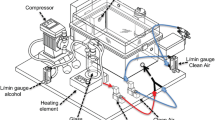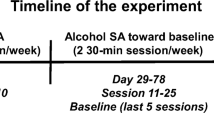Abstract
Rats dramatically increased alcohol preference following the subcutaneous implantation of slow-release d-amphetamine pellets, so long as access to ethanol was withheld during the initial 6 days after pellet implantation. This increased ethanol preference was not due to a conditioned flavor aversion, nor to increased caloric intake, nor to alcohol deprivation. d-Amphetamine must be administered in a continuous fashion in order to obtain this effect, for daily injections of the same amount of the drug did not increase ethanol intake. This increased ethanol preference is interpreted as self-medication. This effect may provide a new animal model for the tension-reduction theory of ethanol intake.
Similar content being viewed by others
References
Cappell H (1975) An evaluation of tension reduction models of alcohol consumption. In: Gibbins RJ, Israel Y, Kalant H, Popham RE, Smart RG (eds) Research advances in alcohol and drug problems, vol 2. John Wiley and Sons, New York
Cappell H, Herman P (1972) Alcohol and tension reduction: A review. Q J Stud Alc 33:33–64
Elkins RL (1974) Conditioned flavor aversions to familiar tap water in rats: An adjustment with implications for aversion therapy treatment of alcoholism and obesity. J Abnorm Psychol 83:411–417
Hodgson RJ, Stockwell TP, Rankin HP (1979) Can alcohol reduce tension? Behav Res Ther 17:459–466
Mills KC, Bean JW (1978) Stress-induced consumption of ethanol. Chemotherapy instead of calories? In: Seixas FA (ed) Currents in alcoholism, vol 3. Biochemical and clinical studies. Grune and Stratton, New York, pp 203–219
Nielson EB, Ellison GD (1980) A silicone pellet for long term continuous administration of d-amphetamine. Commun Psychopharmacol 4:17–20
Sinclair JD (1972) The alcohol deprivation effect, influence of various factors. Q J Stud Alc 33:769–782
Sinclair JD, Senter RJ (1967) Increased preference for ethanol in rats following alcohol deprivation. Psychonom Sci 8:11–12
Sinclair JD, Walker S, Jordan W (1973) Behavioral and physiological changes associated with various durations of alcohol deprivation in rats. Q J Stud Alc 34:744–757
Author information
Authors and Affiliations
Rights and permissions
About this article
Cite this article
Potthoff, A.D., Ellison, G. Low-level continuous amphetamine administration selectively increases alcohol consumption. Psychopharmacology 77, 242–245 (1982). https://doi.org/10.1007/BF00464574
Received:
Accepted:
Issue Date:
DOI: https://doi.org/10.1007/BF00464574




